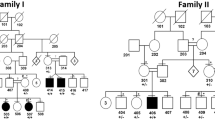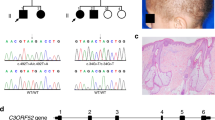Abstract
Pathogenic mutations in a large number of human epithelial keratins have been well characterized. However, analogous mutations in the hard α-keratins of hair and nail have not yet been described. Monilethrix is a rare autosomal dominant hair defect with variable expression. Hairs from affected individuals show a beaded structure of alternating elliptical nodes and constrictions (internodes). These internodes exhibit a high propensity to weathering and fracture. Strong evidence that trichocyte keratin defects might underlie this hair disorder was provided by genetic linkage analyses that mapped this disease to the type-ll keratin gene cluster on 12q13. All affected individuals from a four-generation British family with monilethrix, previously linked to the type-ll keratin gene cluster, as well as three unrelated single monilethrix patients, exhibited a heterozygous point mutation in the gene for type-ll hair cortex keratin hHb6, leading to lysine substitution of a highly conserved glutamic acid residue in the helix termination motif (Glu 410 Lys). In a three-generation French family with monilethrix of a milder and variable phenotype, we detected another heterozygous point mutation in the same glutamic acid codon of hHb6, which resulted in a conservative aspartic acid substitution (Glu 410 Asp). These mutations provide the first direct evidence for involvement of hair keratins in hair disease
This is a preview of subscription content, access via your institution
Access options
Subscribe to this journal
Receive 12 print issues and online access
$209.00 per year
only $17.42 per issue
Buy this article
- Purchase on Springer Link
- Instant access to full article PDF
Prices may be subject to local taxes which are calculated during checkout
Similar content being viewed by others
References
Heid, H.W., Werner, E. & Franke, W.W. The complement of native alpha-keratin polypeptides of hair-forming cells: a subset of eight polypeptides that differ from epithelial cytokeratins. Differentiation 32, 101–119 (1986).
Lynch, M.H., O'Guin, W.M., Hardy, C., Mak, L. & Sun, T.-T. Acidic and basic hair/nail (‘hard’) keratins: their colocalization in upper cortical and cuticle cells of the human hair follicle and their relationship to ‘soft’ keratins. J. Cell. Biol. 103, 2593–2606 (1986).
Powell, B., Crocker, L. & Rogers, G. Hair follicle differentiation: expression, structure, and evolutionary conservation of the hair type II keratin intermediate filament gene family. Development 114, 417–433 (1992).
Winter, H., Siry, P., Tobiasch, E. & Schweizer, J. Sequence and expression of murine type I hair keratins mHa2 and mHa3. Exp. Cell Res. 212, 190–200 (1994).
Fink, P., Rogers, M.A., Korge, B., Winter, H. & Schweizer, J. A cDNA encoding the human type I hair keratin hHa 1. Biochim. Biophys. Acta 1264, 12–14 (1995).
Rogers, M.A. et al. Sequence data and chromosomal localization of human type I and type II hair keratin genes. Exp. Cell Res. 220, 357–362 (1995).
Rogers, M.A., Schweizer, J., Krieg, T. & Winter, H. A novel human type I hair keratin gene: evidence for two keratin hHa3 isoforms. Mol. Biol. Rep. 20, 155–161 (1995).
Rogers, M.A., Winter, H., Langbein, L.,, Krieg, T. & Schweizer, J. Genomic characterization of the human type I cuticular keratin hHa2 and identification of an adjacent novel type I hair keratin gene, hHa5. J. Invest. Dermatol. 107, 633–638 (1996).
Rogers, M.A. et al. Sequences and differential expression of three novel human type-II hair keratins. Differentiation 61, 187–194 (1997).
McLean, W.H.I. & Lane, B. Intermediate filaments in disease. Curr. Opin. Cell Biol. 7, 118–125 (1995).
Steinert, P.M. IF-pathology: molecular consequences of rod and end domain mutations, in Intermediate Filament Structure (eds Parry, D. A.D. & Steinert, P.M.) 145–175 Springer, New York, (1995).
Mckee, G.M. & Rosen, J. Monilethrix: a clinical and histological study, with a report of six cases and a review of the literature. J. Cutan. Dis. incl. Syph. 34, 444–527 (1961).
Gummer, C.L., Dawber, P.R.P. & Swift, J.A. Monilethrix: an electron microscopic and electron histochemical study. Br. J. Dermatol. 105, 529–541 (1981).
Healy, N.E. et al. A gene for monilethrix is closely linked to the type II keratin gene cluster at 12q 13. Hum. Mol. Gen. 4, 2399–2402 (1995).
Stevens, H.P. et al. Linkage of monilethrix to the trichocyte and epithelial keratin gene cluster on 12q11-q13. J. Invest. Dermatol. 106, 795–797 (1996).
Korge, B.P. et al. Monilethrix links to the keratin type II cluster at 12q13 and cloning of a possible candidate gene [abstract]. J. Invest. Dermatol. 106, 843 (1996).
De Berker, D.A.R., Ferguson, D.J.P. & Dawber, R.P.R. Monilethrix: a clinicopathological illustration of a cortical defect. Br. J. Dermatol. 128, 327–331 (1993).
Ito, O.M., Hashimoto, K., Katsuuni, K. & Sato, Y. Pathogenesis of monilethrix: computer stereography and electron microscopy. J. Invest. Dermatol. 95, 186–194 (1990).
McLean, W.H.I. et al. Ichthyosis bullosa of Siemens–a disease involving keratin 2e. J. Invest. Dermatol. 103, 277–281 (1994).
Kremer, H. et al. Ichthyosis bullosa of Siemens is caused by mutations in the keratin 2e gene. J. Invest. Dermatol. 103, 286–289 (1994).
Rothnagel, J.A. . et al. Mutation in the rod domain of keratin 2e in patients with ichthyosis bullosa of Siemens. Nature Genet. 7, 485–490 (1994).
Hatzfeld, M. & Weber, K. Modulation of keratin intermediate filament assembly by single amino acid exchanges in the consensus sequence at the C-terminal end of the rod domain. J. Cell Sci. 99, 351–362 (1991).
Steinert, P.M., Yang, J.M., Bale, S.J. & Compton, J.G. Concurrence between the molecular overlap regions in keratin intermediate filaments and the locations of keratin mutations in genodermatoses. Biochem. Biophys. Res. Com. 197, 840–848 (1993).
Rock, B., Wilkinson, J.D. & Ebling, F.J.G. Mutations in the hair cortex keratin hHb6 cause the inherited hair disease monilethrix: in Textbook of Dermatology (eds Champion, R. H., Burton, J.L. & Ebling, F.J.G.) 1353 Blackwell Scientific, Oxford,(1992).
Richard, G., Itin, P., Lin, S.P., Bon, A. & Bale, S.J. Evidence for genetic heterogeneity in monilethrix. J Invest. Dermatol. 107, 812–814 (1996).
Author information
Authors and Affiliations
Rights and permissions
About this article
Cite this article
Winter, H., Rogers, M., Langbein, L. et al. Mutations in the hair cortex keratin hHb6 cause the inherited hair disease monilethrix. Nat Genet 16, 372–374 (1997). https://doi.org/10.1038/ng0897-372
Received:
Accepted:
Issue Date:
DOI: https://doi.org/10.1038/ng0897-372
This article is cited by
-
Alopezien und Hypotrichosen im Kindesalter: Wann muss an genetische Diagnostik gedacht werden?
Monatsschrift Kinderheilkunde (2021)
-
Keratin 86 is up-regulated in the uterus during implantation, induced by oestradiol
BMC Developmental Biology (2020)
-
An Autosomal Recessive Mutation of DSG4 Causes Monilethrix through the ER Stress Response
Journal of Investigative Dermatology (2015)
-
Inherited desmosomal disorders
Cell and Tissue Research (2015)
-
Alopezien und Hypotrichosen im Kindesalter
Der Hautarzt (2014)



